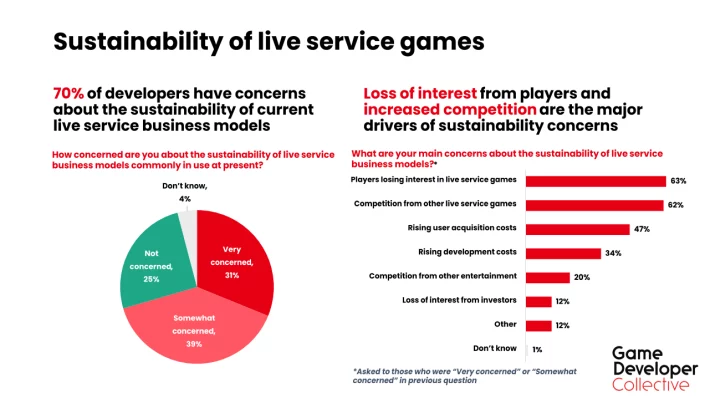Many publishers rely on live service games, sometimes more and sometimes less successfully. However, a recent survey of developers finds that there are major concerns.
Live service games can bring publishers regular and, above all, high income, as “Fortnite”, “Warzone” and Co have made clear in recent years. Other companies want to jump on the bandwagon.
Advertisement
The results of a survey published in February showed that 95 percent of developers work on live service projects, which includes the development, planning and support of existing games. More than 500 studios took part in the survey.
While there are fears of a live service flood, developers are equally worried, another survey has found. A large group of them is particularly skeptical about the sustainability of live service games.
Fear of players losing interest
In the course of a survey by the Game Developer Magazine 600 developers were surveyed between February and March. The focus was on the business models and monetization of video games.
Participants were asked, among other things, to what extent they were concerned about the sustainability of current business models for live services.
Advertisement
39 percent of developers surveyed said they were “somewhat worried.” 31 percent were “very worried,” while 25 percent were not worried and four percent had no opinion.
More interesting than the sheer percentage of developers concerned about the sustainability of live service games are the reasons behind this concern. The participants also provided information on this. The biggest concern is that players might lose interest.
In fact, in recent years, live service games have appeared on the market only to disappear after just a few months. But other reasons also increase concerns.
These are the developers' biggest fears:
- Players are losing interest in a live service game – 63 percent
- Competition from other live service games – 62 percent
- Rising cost of player acquisition – 47 percent
- Rising development costs – 34 percent
- Competition from other entertainment offerings – 20 percent
- Investors lose interest – 12 percent
- Other reasons – 12 percent
Analysts also expect it to be a difficult year for live service games:
Long-lasting monetization is the ultimate goal
How are live service games defined? These typically include games that continuously receive new content after their release – for example, over regular seasons with Battle Pass offers.
The aim of such productions is to retain players in the long term and encourage them to invest more money in the respective title through microtransactions or subscriptions.
The income generated by “GTA Online”, “Roblox”, “Fortnite” and other greats in the genre arouses desire. Sony wanted to push ahead with a live service initiative, which lost momentum.
While “The Last of Us Online” will no longer be pursuedshows “Helldivers 2” However, targeted use can be profitable.
Further reports on the topic:
Also Warner Bros Discovery wants to go the live service route: “Instead of launching a one-off console game, we should create a game that is about, for example, Hogwarts Legacy or Harry Potter and is a live service where people come today and live, work, in this world, “We can build and play on a continuous basis,” said JB Perrette, CEO of global streaming and gaming services, recently.
However, the players' time is limited and the largest player base already focuses on a few live service games.
Further news about live service.
Discuss this news in the PlayStation Forum
Links to Amazon, Media Markt, Saturn and some other retailers are usually affiliate links. When you make a purchase, we receive a small commission with which we can finance the free-to-use site. You have no disadvantages.
